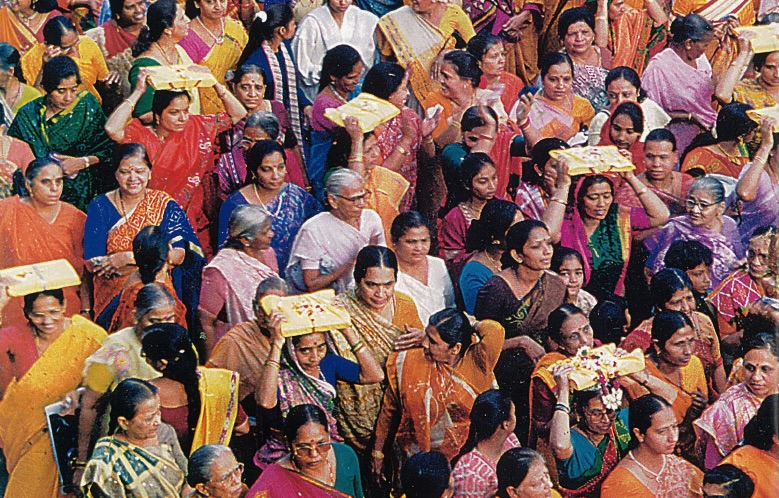When a religious leader who is rooted in orthodox tradition inspires devotional zeal in devotees, that movement flourishes and endures. Clearly, Indira Bettiji Goswami, affectionately known as “Jiji” to her followers, is such a pacesetter. She has traveled the world, transforming lives by awakening the spirit of devotion and service in Hindus who had given up hope even in themselves. The exuberance and magnitude with which her latest temple opened in Baroda, Gujarat, epitomizes the dynamism and fruition of her progressive, unmistakably Hindu mission.
From June 17 to June 27, and again on August 30, 1999, Jiji presided over the elaborate opening ceremonies for the temple of Sri Nathji called the Manjalpur Mandir. Her followers claim the event heralds a renaissance of Hindu dharma, and their devotions alone may have proven them right. Night and day, crowds numbering in the tens of thousands gathered for darshan, ceremonies, yagnas, parades, discourses, prasada, music and dance dramas. The festivities continued for ten days, with guests coming from all walks of life. Yajna, the fire ceremony, commenced on June 17 and continued along with auxiliary festivities until the 27th. The temple was ritually opened on August 30.
Use of the original temple, Giriraj Bhavan, located in the heart of Baroda, had grown immensely over the past 20 years. The huge crowds could no longer be accommodated there, especially during such popular festivals as Janmasthami, Diwali, and Govardhana Puja. Thousands would throng the streets for hours, hoping to get inside to have darshan of Jiji and her personal Deity, Sri Nathji. Thus, the impetus for the move was expansion. The newly opened Manjalpur Mandir lies in a suburban area, where it can accommodate large crowds without difficulty. The temple is in a popular North Indian style, built as a luxurious home for the Gods.
It is a Vedic tradition in India, when relocating Deities to a new temple to escort them in grand procession. Everyone is invited to join the parade. In this way thousands celebrated Sri Nathji’s move into His new home. The three-kilometer parade route was decorated with countless Indian flags along with the saffron-orange flag of Hindu dharma. Flowers and banners were strung every which way. Of seven colorfully decorated floats, the first two carried the temple Deity, Sri Nathji, and the others carried Jiji and visiting spiritual leaders. Local musical troupes and kirtan singers rode on a decorated ox cart singing songs about Krishna. Over 5,000 students from several schools and universities walked the entire three kilometers, chanting patriotic slogans and waving the Hindu and Indian flags.
Among the dignitaries who graced the
occasion was the Governor of Gujarat, Sri Sudarsingh Bhandari, accompanied by ministers and bodyguards, as well as Sri Bhupendra Lahaluwala, Ministry of Gujarat. Attending spiritual leaders included Sant Morari Bapu, Dadaji Krishna Shankar Shastri, Anuben Thakkur, Santram Ramdas Maharaj, Gitaben (Head of Gita Mandir), Goswami Mathureshwar Maharaj (Jiji’s brother) and many other Goswamis. It was a synergy of the spirit as Morari Bapu and the other saints joined together with Jiji to ignite the flame of Hindu devotion, performing Vedic rituals for peace, prosperity and the unity of the Hindu world.
The mood was also one of spiritually inspired patriotism, as the India-Pakistan conflict was flaring. Moving the temple had been well planned prior to the outbreak, so rather than cancel or postpone the event, all the auspiciousness of the occasion was dedicated to the soldiers defending Kashmir, and all monies donated were directed toward the soldiers fighting on the front lines of the invaded territory.
Such an approach is standard procedure for Jiji. In an earlier interview she told Hinduism Today [November, 1997], “One should reform society and also do the work of Sanatana Hindu Dharma. Religion without humanity is lame, and humanity without religion is blind.” And on the need for the Dharma to adapt she offered, “There must be a new approach. Not only books, but also the use of projectors, videos, computer animation, pictures and charts, everything available must be used to teach the children about our tradition, our values and the glorious heritage of India.” The ardor and sheer number of devotees at events such as her temple opening seem to prove her right.
Shree Vallabh Foundation Trust, VrajDham Spiritual Centre, Manjalpur, Baroda 390 011 India.
tel: 91.266.42165; fax: 91.265.424153.
